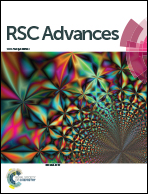CuO nanothorn arrays on three-dimensional copper foam as an ultra-highly sensitive and efficient nonenzymatic glucose sensor†
Abstract
A CuO nanothorns/Cu foam (NTs-CuO/Cu foam) was synthesized using a low-cost and facile method. The morphology and composition of the NTs-CuO/Cu foam were characterized using SEM, TEM and XRD. Copper foam as the current collector played a key role in the formation of the NTs-CuO/Cu foam. The CuO nanothorns were freely grown on copper foam, and can make contact with the underneath conductive copper foam directly. The NTs-CuO/Cu foam was used as an electrocatalyst for the detection of glucose in an electrochemical sensor. The CuO nanothorns/Cu foam electrode shows an extremely high sensitivity of 5.9843 mA mM−1 cm−2 and a low detection limit of 0.275 μM based on a signal to noise ratio of 3. Due to its excellently high sensitivity, stability and anti-interference ability, the NTs-CuO/Cu foam will be a promising material for constructing practical non-enzymatic glucose sensors.


 Please wait while we load your content...
Please wait while we load your content...